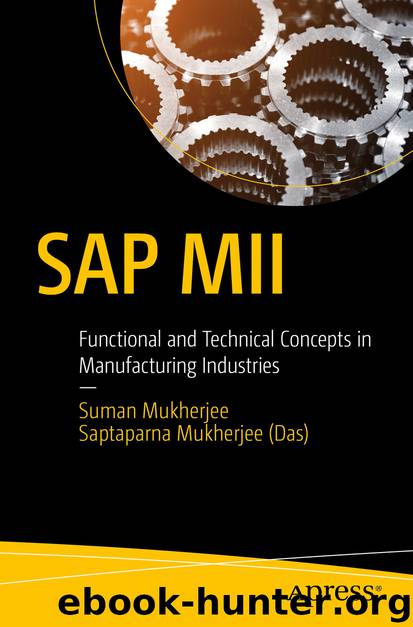SAP MII by Suman Mukherjee & Saptaparna Mukherjee (Das)

Author:Suman Mukherjee & Saptaparna Mukherjee (Das)
Language: eng
Format: epub
Publisher: Apress, Berkeley, CA
Solution with SAP MII
If we consider the integration requirement of pharmaceutical industries, SAP MII can provide the best solution for it. SAP MII has standard connectors available to connect to SAP ECC and can directly fetch data from ECC using push and pull methods. Master data and planning data can be pushed to MII from ECC and MII can store that data and provide rich analytics it. SAP MII can integrate with the shopfloor machines directly using the standard PCo connector. So using SAP MII, it is possible to get the machine data directly in real-time. As visual inspection is an important requirement, SAP MII can integrate with CSV and Excel files directly to read and store the data. SAP MII can provide custom screens for the inspection form to the end users so that they can log the inspection report directly to the SAP MII screens.
Common custom reports used in the pharmaceutical industry include the yield report, the actual versus planned quantity report, delayed versus on-time schedule report, machine overview report, trending report, production rate report, delta report for quality parameters and attributes for individual processes, historical report, machine status capturing the different status of the equipment throughout a selected period, and audit reports (who, when, what, why, and where). These reports are easily created by using SAP MII to gather all the related data from various integrated systems. Similarly, SAP MII can build the product reports to provide complete visibility of individual manufactured product and can provide digital copies of the report, which are easier to store than paper printouts.
Dealing with the high volume of data is another important requirement of pharmaceutical industries, and there are multiple ways to fulfill this requirement using SAP MII. As SAP MII can be hosted on SAP HANA now, this can be one of the great solutions for this requirement. SAP MII can leverage the in-memory processing capability of SAP HANA and can store the data in HANA DB. It will make the process faster. Apart from this, SAP MII can go with the traditional way to store the data in any relational database and can generate all the required reports.
Another approach is to use BI. In this case, SAP MII can work as an integrator to move the data to the BI data pool. SAP MII is also capable of statistical calculations like mean, average, and standard deviation, which are critical process parameters and critical quality attributes. Due to its flexibility to connect to any legacy system and any SAP system, SAP MII makes it very easy to represent near-to real-time data within a reasonable time period.
Download
This site does not store any files on its server. We only index and link to content provided by other sites. Please contact the content providers to delete copyright contents if any and email us, we'll remove relevant links or contents immediately.
| Access | Data Mining |
| Data Modeling & Design | Data Processing |
| Data Warehousing | MySQL |
| Oracle | Other Databases |
| Relational Databases | SQL |
Algorithms of the Intelligent Web by Haralambos Marmanis;Dmitry Babenko(16234)
Azure Data and AI Architect Handbook by Olivier Mertens & Breght Van Baelen(7674)
Building Statistical Models in Python by Huy Hoang Nguyen & Paul N Adams & Stuart J Miller(7655)
Serverless Machine Learning with Amazon Redshift ML by Debu Panda & Phil Bates & Bhanu Pittampally & Sumeet Joshi(7529)
Driving Data Quality with Data Contracts by Andrew Jones(7292)
Data Wrangling on AWS by Navnit Shukla | Sankar M | Sam Palani(7290)
Machine Learning Model Serving Patterns and Best Practices by Md Johirul Islam(7029)
Learning SQL by Alan Beaulieu(6237)
Weapons of Math Destruction by Cathy O'Neil(6214)
Big Data Analysis with Python by Ivan Marin(5933)
Data Engineering with dbt by Roberto Zagni(4931)
Solidity Programming Essentials by Ritesh Modi(4565)
Time Series Analysis with Python Cookbook by Tarek A. Atwan(4399)
Pandas Cookbook by Theodore Petrou(4086)
Blockchain Basics by Daniel Drescher(3540)
Natural Language Processing with Java Cookbook by Richard M. Reese(3143)
Hands-On Machine Learning for Algorithmic Trading by Stefan Jansen(3042)
Learn T-SQL Querying by Pam Lahoud & Pedro Lopes(2929)
Feature Store for Machine Learning by Jayanth Kumar M J(2925)
